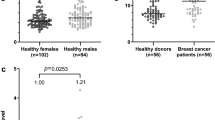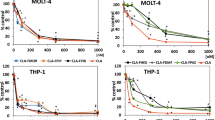Abstract
O6-alkylguanine-DNA-alkyltransferase (ATase) levels were measured in extracts of peripheral blood lymphocytes taken at various times during chemotherapy from 19 patients with various haematological malignancies. Seven patients with advanced Hodgkin's disease received preparative treatment consisting of cyclophosphamide (1.5 g m-2, daily) administered on days 1 to 4 and BCNU (600 mg m-2) on day 5 prior to autologous bone marrow rescue (ABMR) delivered on day 7. Treatment in the remaining 12 patients consisted of cyclophosphamide (1.8 g m-2, daily) given on days 1 and 2 followed at day 4 with total body irradiation (TBI) administered in six fractions over the subsequent 3 days to a total dose of 1200 cGy prior to bone marrow transplantation. In the Hodgkin's group, significant decreases in ATase activity were seen during the cyclophosphamide treatment, and the median ATase nadir was 32% (range 0% to 57%) of pretreatment levels following 4 days of cyclophosphamide. In one patient, no ATase activity was detectable following the 4th cyclophosphamide treatment. ATase activities decreased further after BCNU administration to a median of 19% (range 0% to 32%) of pretreatment levels. Extensive cyclophosphamide-induced reduction of lymphocyte ATase levels was also seen in the other group of 12 patients treated with cyclophosphamide/TBI: postcyclophosphamide median ATase nadir was 35% (range 12% to 78%) of the pretreatment levels. No ATase depletion was seen when cyclophosphamide (up to 10 mM) was incubated for 2 h with pure recombinant human ATase in vitro whereas ATase activity was reduced by 90% on preincubation with 100 microns acrolein or with greater than 1 mM phosphoramide mustard. This suggests that a cyclophosphamide-induced decrease in ATase levels in human peripheral lymphocytes in vivo may be due to depletion mediated by the production of intracellular acrolein. Since ATase appears to be a principal mechanism in cellular resistance to the cytotoxic effects of BCNU and related alkylating agents, these observations suggest that a cyclophosphamide-induced reduction in ATase activity may be an additional factor in the effectiveness of the combined sequential therapy.
This is a preview of subscription content, access via your institution
Access options
Subscribe to this journal
Receive 24 print issues and online access
$259.00 per year
only $10.79 per issue
Buy this article
- Purchase on Springer Link
- Instant access to full article PDF
Prices may be subject to local taxes which are calculated during checkout
Similar content being viewed by others
Author information
Authors and Affiliations
Rights and permissions
About this article
Cite this article
Lee, S., Crowther, D., Scarffe, J. et al. Cyclophosphamide decreases O6-alkylguanine-DNA alkyltransferase activity in peripheral lymphocytes of patients undergoing bone marrow transplantation. Br J Cancer 66, 331–336 (1992). https://doi.org/10.1038/bjc.1992.265
Issue Date:
DOI: https://doi.org/10.1038/bjc.1992.265
This article is cited by
-
Cyclophosphamide promotes pulmonary metastasis on mouse lung adenocarcinoma
Clinical & Experimental Metastasis (2008)



